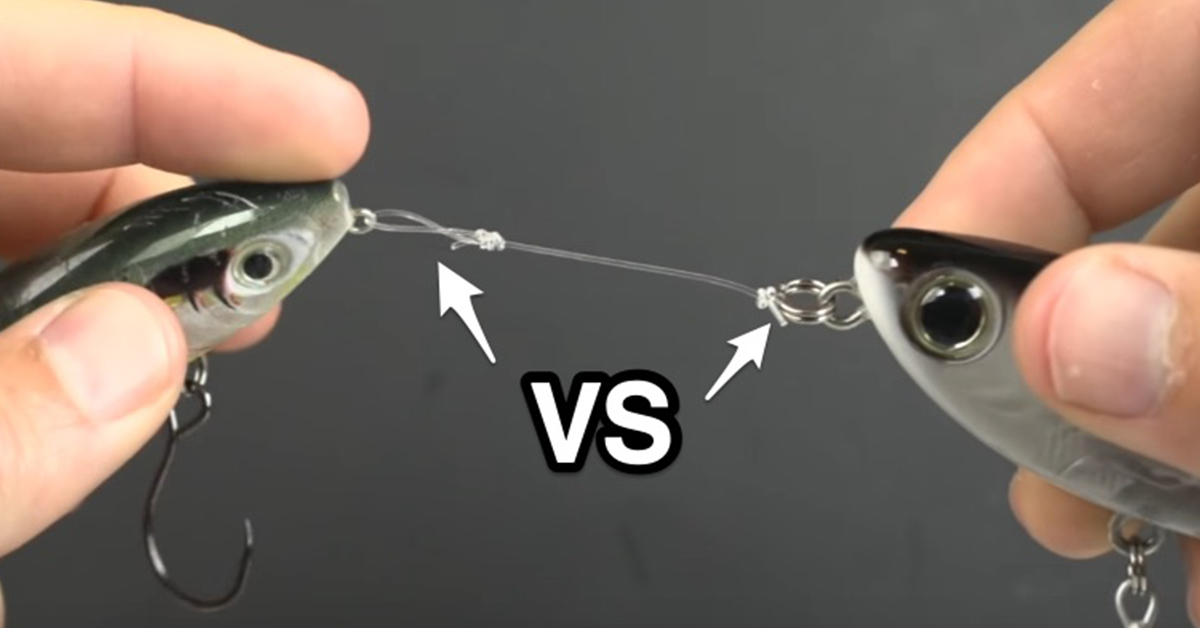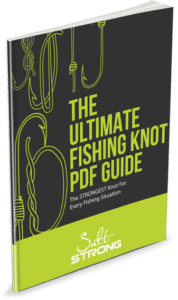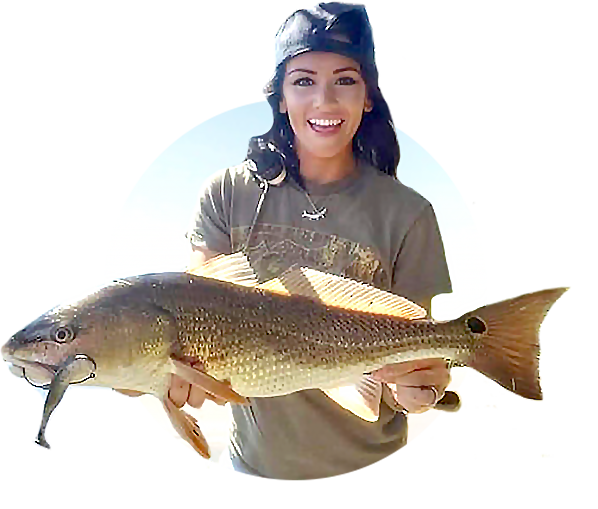When To Use A Loop Knot vs. A Split Ring With Fishing Lures (VIDEO)
- By: Luke Simonds
- on
- Found In: Fishing Knots, Fishing Q&A, Fishing Tips, Terminal Knot (Loop)

Do you know when to use a loop knot vs a split ring with each one of your lures?
This seems to cause some confusion to many anglers (especially with topwater lures – which usually come standard with a split ring).
And recently one of our subscribers, Dale Landry, asked when are the best scenarios to use split rings vs a loop knot.
So we put together this video that discusses the following:
- When to avoid using a split ring on a lure
- When to avoid using a loop knot with certain lures
- Pros and cons of both options
Enjoy and tight lines!
Related Post: 7 Essential Fishing Lures That Can Catch Fish Anywhere (see it here now)
Loop Knot vs Split Ring
Any questions?
Any other tips that work for you when it comes to using a split ring vs a loop knot with any type of fishing lure?
Let us know in the comments below.
 Do You Know The STRONGEST Fishing Knot For Every Situation?
Do You Know The STRONGEST Fishing Knot For Every Situation?
The results of these knot strength tests might surprise you!
Click here to download the FREE “Ultimate Fishing Knot PDF Guide” (only takes a few seconds)
P.S. – If you think any of your angler friends or fishing networks would like to see this, please Tag them or Share this with them. You Rock! Pa-POW!
Related categories:
STOP WASTING TIME ON THE WATER!
Do what the “SMART ANGLERS” are doing and join the Insider Club.
Here’s what you’ll receive today when you join:
- Weekly fishing reports and TRENDS revealing exactly where you should fish every trip
- Weekly “spot dissection” videos that walk you through all the best spots in your area
- Exclusive fishing tips from the PROS you can’t find anywhere else
- Everything you need to start catching fish more consistently (regardless if you fish out of a boat, kayak, or land).










I had a big tarpon on for about 5 minutes on a big rattle trap. I had it tied snug to the split ring on 60 pound fluoro. I’d changed the hooks but not the split ring which straightened out. Lesson learned.
Try Owner split rings, I have never had one fail. And always tie to a solid ring, then split ring to lure
Good idea. Thanks.
I’ve had problems with the line being shredded if the knot drops down into the split ring opening when fighting a fish so I re-tie often when using a split ring. Have you had issues with this?
I have not had any issues with that, but it is definitely a valid concern because once the knot gets in the gap, it’s prone to getting damaged.
Is it possible to use a split ring on plastics? It would help when wanting to quickly change colors.
It is technically possible to use a split ring on any lure. I personally do not use them on soft plastics because they aren’t specifically needed and I like to keep everything as simple and clean as possible. As for switching colors, the quickest method would be to just unhook the tail that’s being used, and then replace it with a different tail on the same jig head or weighted hook. If you’re using soft plastic swim baits that prohibit the ability to replace tails quickly, then a snap swivel would be the faster choice because they are much easier to use than a split ring.
But overall, I rarely ever change a soft plastic tail due to it’s color alone… the lure’s action in the water is the most important factor, and that can be changed by altering retrieve speed and tempo. The next most important factor is the size of the lure because fish can most often just make out the silhouette of the lure (especially when looking up at it from below). So the actual color doesn’t seem to be an important enough variable to worry about switching.
Here’s an example of fish hitting lures of all different colors in one spot: https://saltstrongdev.wpengine.com/articles/best-lures-for-redfish/
I watched your video and agree with all points, not so sure the ring would scare fish if those dangling hooks don’t. I have had bad experience with loop knots and fluorocarbon . Lost some nice fish, then I looked up pros and cons and canoe not is not recommended for fluorocarbon . Lot of variables. I would rather maybe have a lil less on presentation and be confident in my knots. It hard to weigh it all out. Uniknot is good but will slip tight. I am still learning , always open to suggestions, there is nothing better then testing and proven. It’s why I love this group of fishermen.
Thanks for making time to leave the nice comment William. Yes, I saw the same results when testing the Canoe Man Loop knot out against the other top choices… it did well with traditional mono, but it did not match up with fluorocarbon very well… here are the results of the fluorocarbon test: https://saltstrongdev.wpengine.com/articles/best-loop-knot-for-fluorocarbon-leader/
My recommendation is to make sure that you know what your weakest point is regardless of which knot you use so that you know your threshold. I prefer to use the Non-Slip Loop knot for all lures that don’t come with split rings because it’s quick to tie, leaves the tag end pointed back to the lure, and it’s strong enough keep me confident when hooked up to a bigger than planned fish. One big aspect is that I generally use a relatively light braid for the target fish with a much stronger leader to handle the extra abuse that the business end receives, so even a weak knot on the 30lb+ leader can still be as strong as a really good knot on 10 lb line… when I’m using a 30 lb leader, my tension-based breakoffs are always at the line-to-line knot. If I’m using 25 lb leader, it’s generally a 50/50 shot if I get my leader back or not. And when I’m using 20 lb line, I’ll almost always get my leader back after any breakoff.
The No Knot Fas Snap (XL size) offers the best of both attachment types. It’s all I use except for sub-surface applications in super clear water, when I still rely on the loop knot.
Thanks for sharing the tip Gary! How much force can they handle?
Luke…..don’t know how they’re rated force-wise, and when you first look at one you’ll question whether it can hold up, but it will, as years of bringing in over-slot reds and snook will attest to.
Thanks Gary! Sure seems like they are strong enough then. I def like their low profile and how easy it looks to enable a quick lure change.
Right, Luke. Try em – you’ll like em. The only minor negative is after making several lure changes, the spring steel opens up a bit leaving a slightly wider gap, however, I’ve still not had a lure come off while fishing. When the gap becomes a concern, simply replace it. They’re great for topwater lures, but I still like the loop knotted fluoro for subsurface fishing in super clear water or when fish are spooky.
In the topwater scenario with the split ring; shouldn’t we be using a floating leader, like mono? Then would it really be a problem with the split ring sinking, threatening to get the line caught in the front hook?
I have been using all traditional mono for a couple months to see if I could tell a difference in results, and I haven’t really noticed any changes at all in catch per hour results.
As for the traditional mono line floating, I have not yet seen that happen… I believe that it does sink, but just not quite as fast as fluorocarbon. And if just using ~24 inches of it for leader, the difference in how much one actually sinks vs the other most likely very small.
I like to change lures a lot so I started using quick clips snaps to avoid tying knots. But just like Luke observed with the split ring I found my line fouling on the treble hook more often whenI used the quick clip.
Thanks for making time to leave the helpful comment Gene!
In my experience there is a con to trolling using a standard split ring for trolling in that the location of the knot on the ring can have a pretty significant impact on how true the lure runs.
On one hand, if you tie on the spot where there is only one wire (between where the wire ends are) the lure will always run true, but you risk nicking your line by the wire ends or having the knot slide slightly thereby pinching the line between where the wire is doubled. Both of which will drastically weaken your connection.
On the other hand, if you tie on the doubled spot on the ring, you won’t have the aforementioned issues but MANY times you simply can’t get your lure to run true, no matter how you try to tune your lure. And trying to tie 90 degrees (1/4 turn) from the split, your knot will occasionally slide around to the single wire spot, loosening your knot (as it was previously tied around two wires) AND get you back to the issue with nicking and pinching.
My solution is to replace round split rings with oval ones or use the “quick change” ones, though for trolling for big fish (I’ve done A LOT of striper trolling) I highly recommend NOT using the quick release style for strength reasons.
Just tought I’d share my experience and thoughts on part of what you touched on in the video.
Keep those drags screamin’ !
Luke thank you for your insight and taking the time to talk about this issue. You mentioned the strength difference in the loop knot vs the “snug” knot on the split ring. Please quantify that difference.
Mike Teague, you have an excellent thought as well. I have a number of the oval split rings that I should be using on my trolled lures.
That answer of course depends on many variables (knots used, line pairings with knots, etc.), but a general theme can be seen when looking at the results from these two knot contests that used the same lines:
– Snug Knot Contest: https://saltstrongdev.wpengine.com/articles/best-fishing-knot-leader-to-hook/
– Loop Knot Contest: https://saltstrongdev.wpengine.com/articles/best-loop-knot-for-fluorocarbon-leader/
The top loop knot was breaking in the 22 lb to 24 lb range while the top snug knot was breading in the 25 lb to 26 lb range… so a really good snug knot can be estimated to be ~10% stronger than a really good loop knot.
Thanks so much for making time to leave the helpful comment Mike!
That’s the same issue I have with the split rings n my knots getting down into the split ring opening. I re-tie often. I’m not sure if there’s anything else a guy can try with different knots or not.